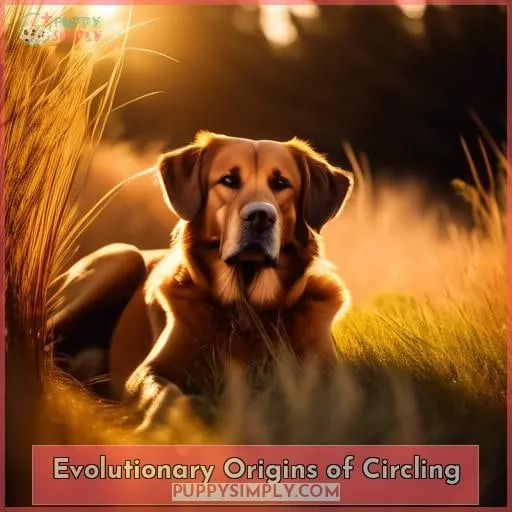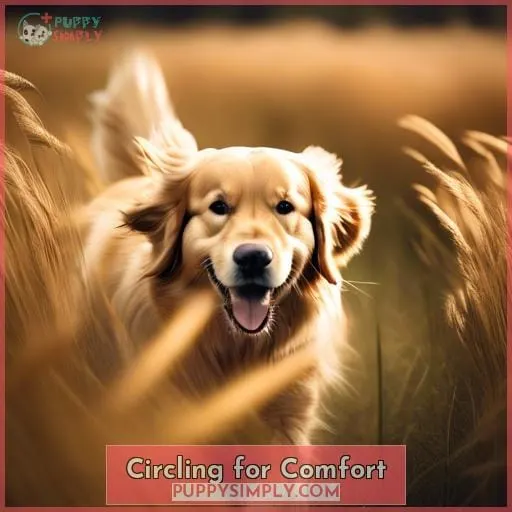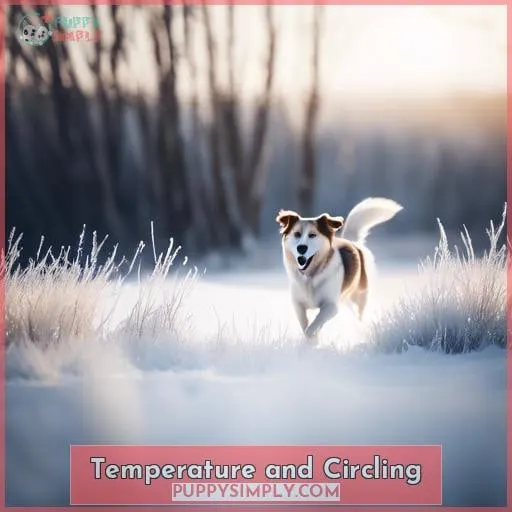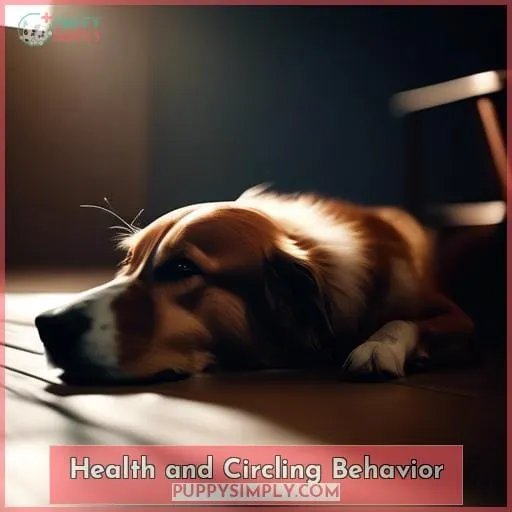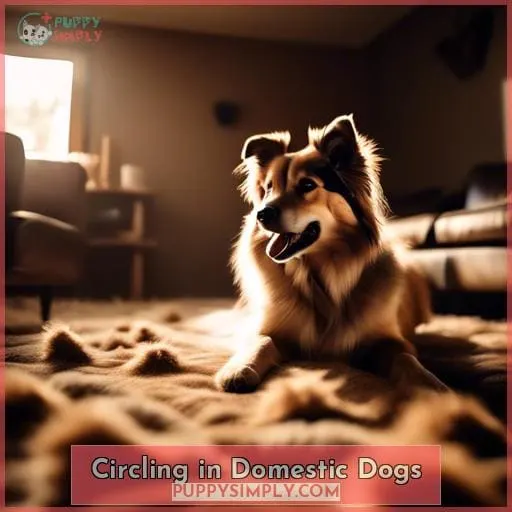This site is supported by our readers. We may earn a commission, at no cost to you, if you purchase through links.
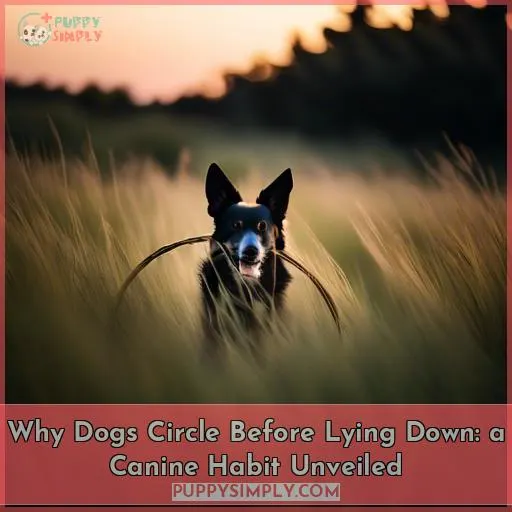 Dogs, our loyal companions, often engage in a peculiar ritual before settling down for a nap or a night’s rest: they circle their chosen spot.
Dogs, our loyal companions, often engage in a peculiar ritual before settling down for a nap or a night’s rest: they circle their chosen spot.
This intriguing behavior, known as circling before lying down, has puzzled dog owners and researchers alike, leading to various theories about its purpose.
Join us as we delve into the world of canine behavior, uncovering the evolutionary roots and potential reasons behind this fascinating habit.
Table Of Contents
- Key Takeaways
- Evolutionary Origins of Circling
- Circling for Comfort
- Temperature and Circling
- Pack Dynamics and Security
- Scent Marking and Territory
- Health and Circling Behavior
- Circling in Domestic Dogs
- When to Seek Veterinary Advice
- Frequently Asked Questions (FAQs)
- How does circling before lying down help dogs communicate with each other?
- Do all dog breeds exhibit circling behavior, or is it more common in certain breeds?
- Can a dog’s circling behavior be influenced by its environment, such as the type of bedding or the size of its sleeping area?
- Are there any potential drawbacks or negative consequences associated with circling behavior in dogs?
- Beyond creating a comfortable sleeping area, does circling serve any other social or psychological functions for dogs?
- Conclusion
Key Takeaways
- Circling behavior in dogs is an instinct inherited from ancestors like wolves and wild dogs, providing comfort and protection.
- Dogs circle to create a comfortable and cozy nest by flattening tall grass, uncovering hidden threats, and ensuring a smooth surface.
- Circling also helps regulate body temperature, with dogs exposing cooler soil in hot weather and huddling together for warmth in cold weather.
- Circling allows dogs to check on other pack members, assess their position within the pack hierarchy, and mark their territory through scent marking.
Evolutionary Origins of Circling
Your dog’s circling behavior before lying down can be traced back to its ancestors.
This behavior is an ingrained instinct, a survival mechanism that provided safety and comfort in the wild.
Circling allowed wild dogs to flatten tall grass and clear away debris, creating a comfortable and safe ‘nest’ to rest in.
Inherited From Ancestors
You’ve likely seen your dog circle before lying down, a behavior inherited from their ancestors.
Genetic Legacy:
Dogs’ circling behavior is deeply ingrained in their genetic makeup, passed down through generations.
Evolutionary Survival:
This behavior traces back to their wild pack ancestors, for whom survival depended on staying safe and comfortable.
Safety in Numbers:
Wolves and wild dogs circled to create a cozy nest, providing warmth and protection from predators.
Ancestral Instinct:
Today’s domesticated dogs retain this instinct, circling to replicate their ancestral pack’s safety measures.
Creating a Nest
Your dog’s ancestors created nests to sleep in, a behavior preserved by instinct.
Circling helps prepare their sleeping area, ensuring comfort and safety, much like their wild forebears.
Safety Precautions
Circling your dog’s sleeping area may have been a safety precaution against potential dangers like snakes and insects.
Flattening grasses or snow made the area more visible to other dogs, creating a sense of security and reducing the risk of surprise attacks.
Circling for Comfort
When creating a sleeping area, dogs flatten tall grass and uncover hidden threats by circling.
This behavior, retained from wild ancestors, ensures a comfortable and safe resting spot.
Flattening Sleeping Area
When preparing its sleeping spot, a dog instinctively circles to flatten the area, creating a more comfortable and cozy nest.
This behavior, inherited from wild ancestors, involves grass flattening and underbrush removal, mimicking the construction of a safe and comfortable resting spot in the wild.
By flattening the area, a dog ensures a smooth and even surface, enhancing its comfort and promoting a peaceful slumber.
Uncovering Hidden Threats
By circling, dogs can uncover potential threats lurking in their chosen sleeping spot.
This behavior stems from their ancestral need to protect themselves and their pack from danger.
Circling allows them to detect hidden snakes, insects, or other potential hazards that could disrupt their rest or pose a threat to the pack.
This instinctive behavior ensures they select a safe and secure spot to rest and recharge for the day ahead.
Temperature and Circling
You may have noticed your dog scratching at the ground before lying down.
This behavior, known as digging, is thought to help regulate their body temperature.
In hot weather, dogs will dig to expose cooler soil.
In cold weather, they dig to create a sheltered spot to sleep in.
Cooling Down
You’ll find that dogs in hotter climates often scratch away topsoil and grass before circling and lying down.
This behavior exposes cooler soil underneath, providing relief from the heat.
In contrast, dogs in colder climates instinctively circle to conserve body heat, huddling together for warmth.
Their innate survival instincts drive them to seek comfort in any environment, whether it’s cooling down or warming up.
Conserving Body Heat
You gather your pack closely, forming a tight circle to conserve body heat during frigid nights.
Huddled warmth radiates from each member, creating a microclimate of comfort.
Burrow behavior, an instinctual survival strategy, helps trap and retain heat.
The collective body heat of the pack warms the spot, providing a haven from the biting cold.
This behavior, deeply ingrained in your canine nature, ensures winter survival in harsh climates.
Pack Dynamics and Security
In the wild, canids travel in packs with many family members. Turning around helps group leaders assess the pack’s position and check for predators.
Bedtime rotation is a form of self-preservation and protection. The turning routine may identify a wolf’s place in the pack hierarchy.
Assessing the Pack
Many dogs still assess their pack’s whereabouts before settling down for the night.
This behavior is rooted in their wild ancestry, where pack hierarchy, group dynamics, and leadership roles played a crucial role in survival.
Circling allows them to check on other pack members, ensuring the group’s safety and maintaining the pack structure.
Pack Hierarchy
| Alpha Pair | Cooperative Hunting | Decision-Making |
|---|---|---|
| Beta Wolves | Pack Bonding | Conflict Resolution |
| Omega Wolves | Submissive Behavior | Maintaining Order |
Group Dynamics
This ingrained behavior persists in domestic dogs, providing them with a sense of security and belonging.
Positioning for Protection
While circling, you’re positioning yourself in a way that enables protection for yourself and your packmates.
You’re acutely aware of your surroundings, constantly scanning for potential threats.
You assess the location of pack members, ensuring they’re within a safe radius.
You select a spot that offers a clear view of the surrounding area, allowing you to monitor for danger.
You orient yourself strategically, facing potential threats to deter them from approaching.
You circle tightly, compacting the grass or leaves beneath you, creating a more comfortable and insulated sleeping surface.
Scent Marking and Territory
Scent marking plays a crucial role in a dog’s world.
They possess scent glands in their paws, and circling before lying down distributes their scent, marking their chosen sleeping spot as their own territory.
This behavior is instinctive and helps establish their dominance and security within their pack or household.
Claiming Sleeping Spots
Through scent marking, you’re marking your territory and claiming your sleeping spot.
It’s an inherited behavior from your canine ancestry, a pack dynamic that ensures each member has a safe and secure place to rest.
Your circling ritual is a way of communicating with other dogs, saying, This spot is mine.
It’s a subtle yet effective way of maintaining order and harmony within your pack.
Scent Glands in Paws
You’ll find that your dog’s paws have scent glands, which they use to mark their territory and claim their sleeping spot as their own.
As your dog circles, these glands release pheromones that signal to other dogs that the area is taken.
This scent marking behavior is a natural way for dogs to communicate and establish their boundaries.
It’s also a way for them to feel safe and secure in their environment.
Health and Circling Behavior
You can explore the potential link between pain or discomfort and excessive circling.
Investigate whether canine cognitive dysfunction might be a factor in older dogs who suddenly start circling excessively.
Pain and Discomfort
If you’re concerned that your dog’s circling behavior is abnormal, monitor them closely for signs of pain or discomfort.
Conditions like separation anxiety or stress can trigger obsessive-compulsive behaviors, including excessive circling.
Neurological disorders may also cause compulsive circling.
If your dog’s circling is accompanied by other unusual behaviors, consult a veterinarian to rule out any underlying health issues.
Canine Cognitive Dysfunction
Canine cognitive dysfunction, akin to dementia in humans, occasionally sparks obsessive circling.
This condition, driven by age-related brain changes, impairs cognitive function, causing memory loss, disorientation, and alterations in sleep-wake cycles.
As a result, affected dogs may exhibit repetitive circling behavior, among other signs of mental decline.
Circling in Domestic Dogs
As domestic dogs, your canine companions inherit circling behavior from their wild ancestors.
You can observe them patting down tall grass and clearing debris before lying down, an instinctive ritual to uncover threats and create a comfortable sleeping niche.
This inherited behavior endures despite the availability of manufactured doggie beds and pillows.
Habitual Behavior
You’ve likely noticed your dog’s habitual circling before settling down to sleep.
This behavior is ingrained in their DNA, a relic of their wild ancestry.
Over time, it has become a comforting ritual, a familiar routine that provides a sense of safety and security before they drift off to dreamland.
While most dogs circle a few times before lying down, excessive circling may indicate underlying health issues or anxiety.
If you notice a sudden change in your dog’s circling behavior, consulting a veterinarian is prudent.
Comfort in Familiar Rituals
Your dog’s circling ritual before lying down is a comforting habit that provides a sense of security and routine.
This appealing ritual is a familiar behavior that brings comfort in the predictability of its routine.
Circling allows your dog to create a sense of order and control in their environment, offering a sense of safety and belonging.
It’s a way for them to seek comfort and establish a sense of security in their surroundings.
When to Seek Veterinary Advice
If your dog’s circling behavior is excessive or accompanied by signs of discomfort, restless pacing, or sudden behavioral changes, consult a veterinarian.
Rule out underlying medical or behavioral issues that may require attention.
Excessive Circling
If you’re noticing your dog’s circling behavior is excessive or accompanied by other signs of distress, it’s time to consult a veterinarian.
Compulsive circling can be a sign of stress, anxiety, or medical conditions.
Related circling may indicate obsessive behavior or cognitive decline.
Excessive circling driven by anxiety requires behavioral modification.
Underlying medical conditions causing compulsive circling need treatment.
Seeking veterinary advice ensures your dog’s well-being and rules out health issues.
Behavioral Changes
Sometimes you’ll notice your dog circling before lying down.
When this behavior becomes excessive or accompanied by other strange actions, it’s time to consult a veterinarian.
Compulsive circling, obsessive behavior, and displacement activity can indicate stress or anxiety.
These behaviors may also signal an underlying medical issue, such as pain or canine cognitive dysfunction.
If your dog’s circling is accompanied by behavioral changes, it’s crucial to seek veterinary advice to rule out any potential health concerns.
Frequently Asked Questions (FAQs)
How does circling before lying down help dogs communicate with each other?
Circling before lying down isn’t a means of canine communication.
It’s an instinctive behavior inherited from their wolf ancestors for self-preservation and comfort.
Do all dog breeds exhibit circling behavior, or is it more common in certain breeds?
While circling behavior is prevalent across breeds, its frequency may vary.
Certain breeds, influenced by genetics and ancestral traits, might exhibit it more distinctly.
Understanding breed-specific variations can deepen our appreciation for canine diversity.
Can a dog’s circling behavior be influenced by its environment, such as the type of bedding or the size of its sleeping area?
Imagine your dog, a creature of instinct,
Preparing its nighttime haven.
Its circling ritual,
Influenced by the environment’s embrace,
Shapes the comfort it seeks.
Bedding’s softness,
Space’s expanse,
These factors weave a tapestry of slumber.
Are there any potential drawbacks or negative consequences associated with circling behavior in dogs?
Circling behavior in dogs, while instinctive, may indicate underlying discomfort or anxiety.
Consult a veterinarian to rule out potential health issues or environmental stressors causing excessive circling.
Beyond creating a comfortable sleeping area, does circling serve any other social or psychological functions for dogs?
Circling before settling down may fulfill social and psychological needs:
- Strengthening bonds within the pack.
- Providing a sense of security and belonging.
Conclusion
As we’ve discovered, dogs’ pre-sleep circling behavior is a complex tapestry of instinct, comfort, temperature regulation, pack dynamics, scent marking, and potential health concerns.
Understanding this innate behavior deepens our appreciation for our canine companions and enhances our ability to care for them.
If you notice excessive circling or sudden behavioral changes, consulting a veterinarian is always prudent, ensuring your dog’s well-being and harmonious coexistence within your shared home.

